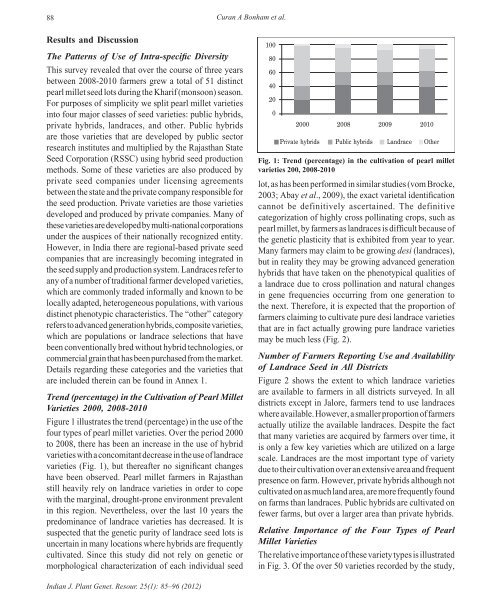indian society of plant genetic resources - Bioversity International
indian society of plant genetic resources - Bioversity International
indian society of plant genetic resources - Bioversity International
You also want an ePaper? Increase the reach of your titles
YUMPU automatically turns print PDFs into web optimized ePapers that Google loves.
88<br />
Results and Discussion<br />
The Patterns <strong>of</strong> Use <strong>of</strong> Intra-specifi c Diversity<br />
This survey revealed that over the course <strong>of</strong> three years<br />
between 2008-2010 farmers grew a total <strong>of</strong> 51 distinct<br />
pearl millet seed lots during the Kharif (monsoon) season.<br />
For purposes <strong>of</strong> simplicity we split pearl millet varieties<br />
into four major classes <strong>of</strong> seed varieties: public hybrids,<br />
private hybrids, landraces, and other. Public hybrids<br />
are those varieties that are developed by public sector<br />
research institutes and multiplied by the Rajasthan State<br />
Seed Corporation (RSSC) using hybrid seed production<br />
methods. Some <strong>of</strong> these varieties are also produced by<br />
private seed companies under licensing agreements<br />
between the state and the private company responsible for<br />
the seed production. Private varieties are those varieties<br />
developed and produced by private companies. Many <strong>of</strong><br />
these varieties are developed by multi-national corporations<br />
under the auspices <strong>of</strong> their nationally recognized entity.<br />
However, in India there are regional-based private seed<br />
companies that are increasingly becoming integrated in<br />
the seed supply and production system. Landraces refer to<br />
any <strong>of</strong> a number <strong>of</strong> traditional farmer developed varieties,<br />
which are commonly traded informally and known to be<br />
locally adapted, heterogeneous populations, with various<br />
distinct phenotypic characteristics. The “other” category<br />
refers to advanced generation hybrids, composite varieties,<br />
which are populations or landrace selections that have<br />
been conventionally bred without hybrid technologies, or<br />
commercial grain that has been purchased from the market.<br />
Details regarding these categories and the varieties that<br />
are included therein can be found in Annex 1.<br />
Trend (percentage) in the Cultivation <strong>of</strong> Pearl Millet<br />
Varieties 2000, 2008-2010<br />
Figure 1 illustrates the trend (percentage) in the use <strong>of</strong> the<br />
four types <strong>of</strong> pearl millet varieties. Over the period 2000<br />
to 2008, there has been an increase in the use <strong>of</strong> hybrid<br />
varieties with a concomitant decrease in the use <strong>of</strong> landrace<br />
varieties (Fig. 1), but thereafter no signifi cant changes<br />
have been observed. Pearl millet farmers in Rajasthan<br />
still heavily rely on landrace varieties in order to cope<br />
with the marginal, drought-prone environment prevalent<br />
in this region. Nevertheless, over the last 10 years the<br />
predominance <strong>of</strong> landrace varieties has decreased. It is<br />
suspected that the <strong>genetic</strong> purity <strong>of</strong> landrace seed lots is<br />
uncertain in many locations where hybrids are frequently<br />
cultivated. Since this study did not rely on <strong>genetic</strong> or<br />
morphological characterization <strong>of</strong> each individual seed<br />
Indian J. Plant Genet. Resour. 25(1): 85–96 (2012)<br />
Curan A Bonham et al.<br />
100<br />
80<br />
60<br />
40<br />
20<br />
0<br />
2000 2008 2009 2010<br />
Private hybrids Public hybrids Landrace Other<br />
Fig. 1: Trend (percentage) in the cultivation <strong>of</strong> pearl millet<br />
varieties 200, 2008-2010<br />
lot, as has been performed in similar studies (vom Brocke,<br />
2003; Abay et al., 2009), the exact varietal identifi cation<br />
cannot be definitively ascertained. The definitive<br />
categorization <strong>of</strong> highly cross pollinating crops, such as<br />
pearl millet, by farmers as landraces is diffi cult because <strong>of</strong><br />
the <strong>genetic</strong> plasticity that is exhibited from year to year.<br />
Many farmers may claim to be growing desi (landraces),<br />
but in reality they may be growing advanced generation<br />
hybrids that have taken on the phenotypical qualities <strong>of</strong><br />
a landrace due to cross pollination and natural changes<br />
in gene frequencies occurring from one generation to<br />
the next. Therefore, it is expected that the proportion <strong>of</strong><br />
farmers claiming to cultivate pure desi landrace varieties<br />
that are in fact actually growing pure landrace varieties<br />
may be much less (Fig. 2).<br />
Number <strong>of</strong> Farmers Reporting Use and Availability<br />
<strong>of</strong> Landrace Seed in All Districts<br />
Figure 2 shows the extent to which landrace varieties<br />
are available to farmers in all districts surveyed. In all<br />
districts except in Jalore, farmers tend to use landraces<br />
where available. However, a smaller proportion <strong>of</strong> farmers<br />
actually utilize the available landraces. Despite the fact<br />
that many varieties are acquired by farmers over time, it<br />
is only a few key varieties which are utilized on a large<br />
scale. Landraces are the most important type <strong>of</strong> variety<br />
due to their cultivation over an extensive area and frequent<br />
presence on farm. However, private hybrids although not<br />
cultivated on as much land area, are more frequently found<br />
on farms than landraces. Public hybrids are cultivated on<br />
fewer farms, but over a larger area than private hybrids.<br />
Relative Importance <strong>of</strong> the Four Types <strong>of</strong> Pearl<br />
Millet Varieties<br />
The relative importance <strong>of</strong> these variety types is illustrated<br />
in Fig. 3. Of the over 50 varieties recorded by the study,

















